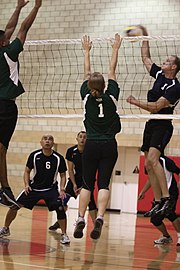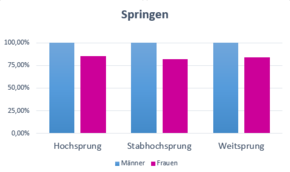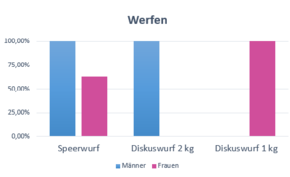Gender differences in sport
As gender differences in sports refers to differences that their being of the male or female sex are returned and an impact on the sport have performance.

history
Men's and women's sports have developed completely differently. Due to historical and social constraints, women were unable to practice many sports until much later than men. For example, the marathon competition for women was not included in the Olympic program until 1984. Due to the late establishment of women's sport , the records rose explosively around 1980–1990 and some scientists predicted that women would overtake men in high-performance sport by 2050 at the latest. Due to the flattening of the "performance explosion" in women's sport around the turn of the millennium, it is currently assumed that the "gender gap" cannot be eliminated due to the genetic differences. The difference in performance between men and women in sport has even increased in recent years. While the difference between the sexes averaged 10.4 percent in 1989, it is currently back at just over eleven percent. The researchers see the reason for this primarily in the disappearance of the "Eastern Bloc" - or the planned doping especially in women's sport in these countries.
Physical differences
Anatomically, men and women also differ in terms of height , weight , muscle mass and physique. Men are on average 12 cm taller and 10 to 20 kg heavier than women. While the body structure of women is trunk-accentuated, in men the extremities are emphasized. Women have smaller airways, and their hearts and lungs are also relatively smaller, their heart rate is relatively higher, the amount of blood and the value of the oxygen transporter hemoglobin are relatively lower than in men. Women have a higher percentage of body fat and less muscle mass, and the metabolism is different in both sexes.
In competitive sports, men achieve an average of 10 to 20% more physical performance in the various disciplines. It is not possible to set up a uniform measure of human performance. Instead, performance is individually defined for each discipline or movement in sport. Examples are given in the table below in the “World Records” section. This effect is stronger, the more it depends on strength. Women's higher fat metabolism is beneficial in ultra-endurance disciplines.
Intersex in sports
Nature offers a wide range of gender characteristics. For example, there are women with elevated testosterone levels and people with androgen resistance who have a female appearance with an XY karyotype . These and other intermediate forms between men and women are summarized under the term intersexuality . This circumstance makes it difficult to find a definition for "woman" that is generally valid for competitive sport.
To prevent men from taking part in women's competitions, gender checks are carried out in suspected cases . The current jurisprudence for international running competitions between 400 m and one mile is that whoever wants to compete in women's competitions has the karyotype XX and has a testosterone level of less than 5 nanomoles / liter of blood for 6 months .
Gender segregation in sports
Due to the different physical capabilities, the sexes are separated in most sports. Often the sports equipment used by women is different, mostly smaller or lighter, than that used by men. For example, the women's basketball is 2.54 cm smaller, the women's volleyball net 19 cm lower and the women's discus 1 kg lighter than its men's counterpart.
Of the 28 different sports at the 2016 Olympic Games , horse riding is the only one in which women and men compete together. Only women are allowed in rhythmic gymnastics and synchronized swimming . Male and female athletes are also separated in shooting at the Olympic Games, although men have no advantage over women in this precision sport. In Switzerland , male and female shooters compete together, for example in boy shooting . Women have been able to participate in shooting competitions since the 1968 Olympic Games in Mexico . First they were integrated into the men's teams. Since Los Angeles 1984 , most female shooting competitions have been conducted separately. The Olympic skeet competition , however, continued to be held together until 1992 , when the Chinese Zhang Shan surprisingly became the first woman to win. Four years later, at the Atlanta Olympics , women were excluded from the skeet competition and Zhang Shan was unable to defend her victory. It was not until 2000 in Sydney that women target shooting became an independent Olympic competition. In other precision sports, such as pétanque , both genders compete together. Until 1988, sailing at the Olympics was not gender segregated.
Sports in which men and women usually compete together are, for example, sports aerobics , snooker , jugger , croquet , many motor sports such as Formula 1 , as well as all equestrian sports : western riding , endurance riding , dressage riding , show jumping , eventing , driving , horse racing , vaulting and competitive plowing . In polo , the physical advantage of men is balanced by the handicap .
Mixed doubles, mixed teams and couples
Mixed doubles of one woman and one man each are played in the setback sports tennis , table tennis and badminton .
There are mixed teams in the water sports sailing , rowing and canoeing ( canoeing ), but also in team sports such as curling , mixed floorball , volleyball , softball , football and ultimate frisbee .
In dancing , figure skating and ice dancing, there are couples competitions in which couples of men and women compete. In figure skating and ballet there are lifting figures in which, due to the physical conditions, the man usually takes on the role of the underman. In vaulting, the taller one takes on the role of the male or female.
Quidditch , an adaptation of the fictional game from the Harry Potter universe, is one of the few sports that requires mixed teams and explicitly includes people with non-binary gender identity .
Sports with peculiarities regarding the gender difference
The gender gap in swimming is 6–15% in favor of men. In swimming , the biological differences are less serious than in other sports.
In Germany, girls and boys usually play football together up to youth level D.
World records
| sport | discipline | record | difference |
|---|---|---|---|
| Throw | Discus throw | 74.08 m (2 kg) |
no comparison possible: different throwing weights |
| 76.80 m (1 kg) |
|||
| To run | Ultramarathon 100 km | 6:10:20 h |
6% |
| 6:33:11 h |
|||
| To run | Marathon run | 2:02:57 h |
9% |
| 2:15:25 h |
|||
| Speed skating | 100 m speed skating | 9.40 s |
9% |
| 10.21 s |
|||
| To run | 100 meter run | 9.58 s |
10% |
| 10.49 s |
|||
| To run | 400 meter run | 43.18 s |
10% |
| 47.60 s |
|||
| To run | 1500 meter run | 3: 26.00 min |
12% |
| 3: 50.07 min |
|||
| swim | 50 m chest | 26.42 s |
12% |
| 29.48 s |
|||
| swim | 50 m back | 24.04 s |
13% |
| 27.06 s |
|||
| swim | 50 m freestyle | 20.91 s |
14% |
| 23.73 s |
|||
| Leap | high jump | 2.45 m |
15% |
| 2.09 m |
|||
| Leap | Long jump | 8.95 m |
16% |
| 7.52 m |
|||
| Leap | Pole vault | 6.16 m |
18% |
| 5.06 m |
|||
| Weightlifting | Tear weight class up to 69 kg | 166 kg |
23% |
| 128 kg |
|||
| Weightlifting | Bump weight class up to 69 kg | 198 kg |
27% |
| 158 kg |
|||
| Weightlifting | Combat weight class up to 69 kg | 359 kg |
20% |
| 286 kg |
|||
| Throw | Javelin throw | 98.48 m (800 g) |
no comparison possible: different throwing weights |
| 72.28 m (600 g) |
Individual evidence
- ↑ Eternal gender difference in sport? In: ORF ON Science. Retrieved January 14, 2019 .
- ↑ A century of trends in adult human height , July 26, 2016
- ↑ Men's Sports - Women's Sports. Retrieved January 28, 2017 .
- ↑ Women's / men's soccer: that's how big the difference really is . In: https://www.tz.de/ . June 25, 2011 ( tz.de [accessed January 28, 2017]).
- ↑ Energy balance and lipid metabolism ( Memento of the original from August 28, 2016 in the Internet Archive ) Info: The archive link was inserted automatically and has not yet been checked. Please check the original and archive link according to the instructions and then remove this notice. , Lutz Aderhold, German Road Races, January 23, 2014
- ↑ Remo Geisser: 800 m run of women: The final run of the controversy . In: Neue Zürcher Zeitung . August 20, 2016, ISSN 0376-6829 ( nzz.ch [accessed January 28, 2017]).
- ↑ These intersex sprinters outclass their opponents - is it the testosterone? In: az Aargauer Zeitung . ( aargauerzeitung.ch [accessed on January 28, 2017]).
- ↑ Sports court rejects Semenya's objection to testosterone limit , Süddeutsche Zeitung
- ↑ http://www.fibaamericas.com/files/informes/A025ACC10A544F25857E5C8576F69696.pdf
- ^ Hall of Fame , Boy Shooting
- ^ Doctor from Saxony pulls Brandenburgers away , Lausitzer Rundschau, September 14, 2016
- ↑ Eva Brühl polo player with handicap 2
- ↑ Barbie & Ken (Eszter Somogyi & Balázs Bence) CVIO Stadl Paura 2010. May 19, 2010, accessed on January 28, 2017 .
- ↑ Jeffrey O. Segrave: Challenging the gender binary: the fictive and real world of quidditch . In: Sport in Society . tape 19 , no. 8/9 , August 17, 2015, ISSN 1743-0445 , p. 1299-1315 , doi : 10.1080 / 17430437.2015.1067783 .
- ^ "Girls and boys together as long as possible" :: DFB - Deutscher Fußball-Bund eV. Accessed on January 28, 2017 .
- ^ Discus throw
- ^ IAU World Best Performances
- ↑ World records in athletics
- ↑ List of speed skating world records
- ↑ World records in athletics
- ↑ List of swimming world records
- ↑ World records in athletics
- ^ List of world records in weightlifting
- ^ List of world records in weightlifting
- ^ List of world records in weightlifting
- ↑ World records in athletics







